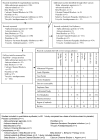Pharmacologic treatment of pediatric headaches: a meta-analysis
- PMID: 23358935
- PMCID: PMC4692044
- DOI: 10.1001/jamapediatrics.2013.508
Pharmacologic treatment of pediatric headaches: a meta-analysis
Abstract
OBJECTIVE To assess the effectiveness of prophylactic headache treatment in children and adolescents. DATA SOURCES PubMed, EMBASE, Cochrane Database of Clinical Trials, and bibliography of retrieved articles through August 11, 2012. STUDY SELECTION Randomized trials of headache treatment among children and adolescents (<18 years old). INTERVENTION Any placebo-controlled trial or comparisons between 2 or more active medications. MAIN OUTCOME MEASURE Number of headaches per month. RESULTS Among 21 included trials, there were 13 placebo-controlled and 10 active comparator trials (2 also included placebo). Twenty trials focused on episodic migraines and 1 on chronic daily headaches. Drugs more effective than placebo for episodic migraines (<15 headaches per month) included topiramate (difference in headaches per month, -0.71; 95% CI, -1.19 to -0.24) and trazodone (-0.60; 95% CI, -1.09 to -0.11). Ineffective drugs included clonidine, flunarizine, pizotifen, propranolol, and valproate. A single trial of fluoxetine for chronic daily headaches found it ineffective. Patients given placebo experienced a significant (P = .03) decline in headaches, from 5.6 (95% CI, 4.52-6.77; Q = 8.14 [Cochran Q is a measure of the heterogeneity of the included studies]) to 2.9 headaches per month (95% CI, 1.66-4.08; Q = 4.72). Among the 10 active comparator trials, flunarizine was more effective than piracetam (difference in headaches per month, -2.20; 95% CI, -3.93 to -0.47) but no better than aspirin, dihydroergotamine, or propranolol. Propranolol was compared with valproate as well as behavioral treatment, and 2 studies compared different doses of topiramate; none of these trials showed significant differences. CONCLUSIONS Topiramate and trazodone have limited evidence supporting efficacy for episodic migraines. Placebo was effective in reducing headaches. Other commonly used drugs have no evidence supporting their use in children and adolescents. More research is needed.
Comment in
-
No evidence of efficacy or evidence of no efficacy.JAMA Pediatr. 2013 Mar 1;167(3):300-2. doi: 10.1001/jamapediatrics.2013.1105. JAMA Pediatr. 2013. PMID: 23358915 No abstract available.
References
-
- Arruda MA, Guidetti V, Galli F, Albuquerque RC, Bigal ME. Primary headaches in childhood: a population-based study. Cephalalgia. 2010;30(9):1056–1064. - PubMed
-
- Anttila P. Tension-type headache in childhood and adolescence. Lancet Neurol. 2006;5(3):268–274. - PubMed
-
- Chong SC, Chan YH, Ong HT, Low PS, Tay SK. Headache diagnosis, disability and co-morbidities in amulti-ethnic, heterogeneous paediatric Asian population. Cephalalgia. 2010;30(8):953–961. - PubMed
-
- Alp R, Alp SI, Palanci Y, et al. Use of the International Classification of Headache Disorders, Second Edition, criteria in the diagnosis of primary headache in schoolchildren: epidemiology study from eastern Turkey. Cephalalgia. 2010;30(7):868–877. - PubMed
-
- Sillanpää M. Changes in the prevalence of migraine and other headaches during the first seven school years. Headache. 1983;23(1):15–19. - PubMed
Publication types
MeSH terms
Substances
Grants and funding
LinkOut - more resources
Full Text Sources
Other Literature Sources
Medical



